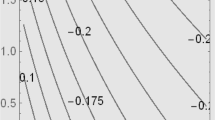Sumary
This paper characterizes the wage setting behavior in a totally unionized economy under different monetary policy strategies. The wage formation strategy of the union can be either aggressive or cooperative. As long as the union is fully cooperative and in the absence of shocks, the government can completely attain its macroeconomic targets: full employment and price stability. If, however, the union becomes unexpectedly aggressive, a constant money supply rule has a nominal wage inflation bias under certain plausible assumptions. By changing the rules of the game,e.g. following a nominal GNP or price level (inflation) rule, wage demands would be lower and the economy better off.
Similar content being viewed by others
References
Argy, V., ‘Nominal Income Targeting: A Critical Evaluation,’ IMF Working Paper, WP 91/92, 1991.
Asako, K. and H. Wagner, ‘Nominal Income Targetingversus Money Supply Targeting,’Scottish Journal of Political Economy, 39 (1992), pp. 167–187.
Barro, R.J. and D.B. Gordon, ‘A Positive Theory of Monetary Policy in a Natural Rate Model,’Journal of Political Economy, 91 (1983a), pp. 589–610.
Barro, R.J. and D.B. Gordon, ‘Rules, Discretion and Reputation in a Model of Monetary Policy,’Journal of Monetary Economics, 12 (1983b), pp. 101–121.
Bean, C., ‘Targeting Nominal Income: An Appraisal,’Economic Journal, 93 (1983), pp. 806–819.
Blanchard, O.J. and S. Fischer,Lectures on Macroeconomics, Cambridge, Massachusetts, 1989.
Chapman, P.G.I., ‘Alternative Trade Union Objective Functions in the Theory of Wage Bargaining,’The Manchester School of Economic and Social Studies, 4 (1986), pp. 367–379.
Dornbusch, R. and J.A. Frankel, ‘The Flexible Exchange Rate System: Experience and Alternatives,’NBER Working Paper No. 2464, 1987.
Fischer, S., ‘Long-term Contracts, Rational Expectations, and the Optimal Money Supply Rule,’Journal of Political Economy, 85 (1977), pp. 191–206.
Fischer, S., ‘Rules versus Discretion in Monetary Policy,’ NBER Working Paper No. 2518, 1988.
Fischer, S. and F. Modigliani, ‘Towards an Understanding of the Real Effects and the Costs of Inflation,’Review of World Economics, 114 (1978), pp. 810–833.
Frankel, J.A., ‘The Obstancles to Macroeconomic Policy Coordination in the 1990s and an Analysis of International Nominal Targeting (INT),’ in: K.A. Koekkoek and L.B.M. Mennes (eds.),International Trade and Global Development: Essay in Honor of Jagdish Bhagwati, 1991, pp. 211–236.
Frankel, J.A. and M. Chinn, ‘The Stabilizing Properties of a Nominal GNP Rule in an Open Economy,’University of California, Berkeley, Working Paper No. 91–166, 1991.
Frankel, J.A. and N. Funke, ‘A Two-country Analysis of International Targeting of Nominal GNP,’Rivista di Politica Economica, 83 (1993), pp. 69–103.
Fukuda, S. and K. Hamada, ‘Towards the Implementation of Desirable Rules of Monetary Coordination. and Intervention,’ in: Yoshio Suzuki and Mitsuaki Okabe (eds.),Toward a World of Economic Stability. Optimal Monetary Framework and Policy, Proceedings of the Third International Conference sponsored by the Institute for Monetary and Economic Studies of the Bank of Japan, Tokyo, 1988, pp. 313–338.
Funke, N., ‘Das internationale nominale Sozialprodukt als geldpolitisches Koordinationsziel: Eine Analyses,’ Institute of World Economics, 1992, forthcoming inKredit und Kapital.
Funke, N., ‘Zur Einkommenskreislaufgeschwindigeit des Geldes bei alternativen geldpolitischen Regeln: Eine Anmerkung,’Jahrbücher für Nationalökonomies und Statistik, 211 (1993), pp. 518–523.
Gray, J.A., ‘Wage Indexation: A Macroeconomic Approach,’Journal of Monetary Economics, 2 (1976), pp. 221–235.
Kydland, F.E. and E.C. Prescott ‘Rules Rather than Discretion: The Inconsistency of Optimal Plans,’Jornal of Political Economy, 85 (1977), pp. 473–491.
McCallum, B.T., ‘The Case for Rules in the Conduct of Monetary Policy: A Concrete Example,’Review of World Economics, 123 (1987), pp. 415–429.
Meade, J.E., ‘The Meaning of Internal Balance,’Economic Journal, 88 (1978), pp. 423–435.
Neumann, M.J.M., ‘Precommitment by Central Bank Independence,’Open Economies Review, 2 (1991), pp. 95–112.
Rogoff, K., ‘The Optimal Degree of Commitment to an Intermediate Monetary Target,’Quarterly Journal of Economics, 100 (1985), pp. 1169–1189.
Scheide, J., ‘A K-Percent Rule for Monetary Policy in West Germany,’Review of World Economics, 125 (1989), pp. 326–336.
Tabellini, G., ‘Centralized Wage Setting and Monetary Policy in a Reputational Equilibrium,’Journal of Money, Credit, and Banking, 20 (1988), pp. 102–118.
Taylor, J.B.,What Would Nominal GNP Targeting Do to the Business Cycle?, Carnegie-Rochester Conference Series on Public Policy, 22 (1985), pp. 61–84.
Weizsäcker, C.Ch. von, ‘Das Problem der Vollbeschäftigung heute,’Zeitschrift für Wirtschafts- und Sozialwissenschaften, 98 (1978), pp. 31–51.
Author information
Authors and Affiliations
Additional information
I thank an anonymous referee for valuable comments on an earlier version of this paper. The usual disclaimer applies.
Rights and permissions
About this article
Cite this article
Funke, N. Centralized wage setting under alternative monetary policy rules. De Economist 142, 327–339 (1994). https://doi.org/10.1007/BF01431976
Issue Date:
DOI: https://doi.org/10.1007/BF01431976




